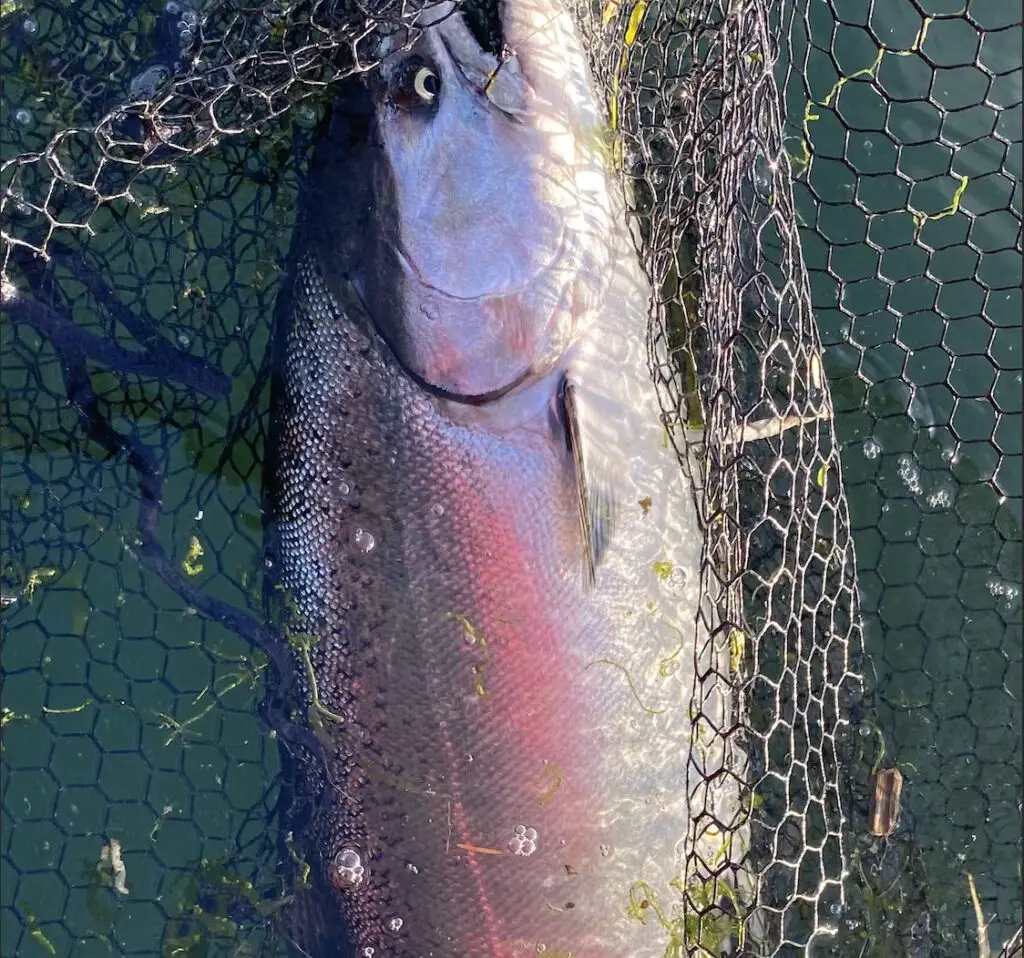
I took my Dad out fishing for chinook and coho in Marine Area 9 on the final set of openings in the limited season for chinook in 2023 and wanted to share our trip experience, and lessons learned and write a little bit about what’s next for Puget Sound chinook anglers.
I love planning fishing trips, hunting trips, whatever trips. I’m an obsessive planner, and master strategist and I love to line up all the variables and chart a course through them to try and find the best on-paper plan for the day.
Of course, as they say, no plan survives first contact with the enemy, so one always needs a few well-thought-through if/then scenarios, aka plan B, plan C, etc.
Most early planning of a fishing trip in salt water needs to include tides. Not just to look at the fishing plan itself, but the launching of the boat plan.
In this case, I wanted to fish Marine Area 9 for salmon for the first time in 2023. Before you judge me as being the Puget Sound salmon fishing blogger and YouTube channel guy who hasn’t taken part in Puget Sound’s premier summer salmon fishing opportunity… I had other plans to go earlier in the season, but the vortex of wonderful chinook salmon fishing that is Westport kept sucking me back in!
Okay, now you can judge me. Look, I’m a chinookaholic and I don’t really care where the chinook are, and the fishing out of Westport has been so stupid good…I’m hoping to go a few more times this week in fact!
Okay, so I finally got my act together and stuck to my guns on fishing Marine Area 9 (really just because the wind kicked up at Westport!). I decided to launch at Kingston.
The launch and trip plan
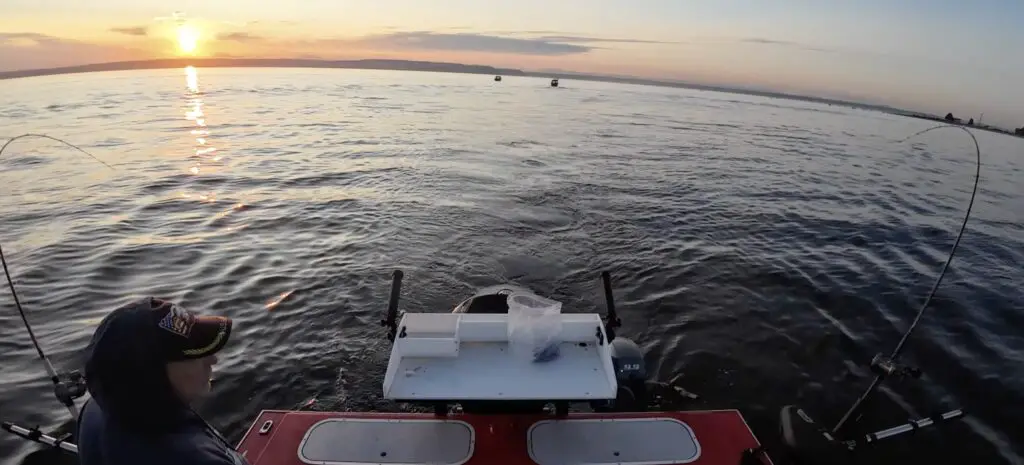
Now, Kingston is a pretty good launch, you can generally get a big boat in the water there on a wide range of tides, but low tide was positive .7 ft at around 6 am.
Ever sat behind a guy at the launch with a 30′ offshore boat or big fiberglass boat trying to launch in just enough water to get out?
So, even though sunrise was closer to 5:40 am, my launch plan was 4:45 am and I arrived and was backing down the ramp just as 4-5 other boats all showed up at once. So one thing went right in my plan that today even though it meant getting up hella early to execute it.
I always like to default to earlier, it’s honestly the only variable you get to completely control in a day of fishing with too many variables outside of your control. You do get to decide when you wake up in the morning.
So, we hit that part just right, and we were off running to Point No Point.
The other part of the tide plan is that there was a remaining ebb that would allow some fishing opportunity going east to west, around Skunk Bay, west of Point no Point.
I realize, in that one statement there are a few concepts to unpack for those who are newer to the game here:
Tide books show you what the tide is doing at shore, but the tide out on the water is always behind the shore tide situation. Here’s an example:
Low tide at 6am in Kingston, could translate to a current change in 120 ft of water at 8am, and a current change (low tide) at 9am for 300 ft of water.
The tides change in layers. So just because you launched at one tide, don’t assume the current in the depth of water you are fishing is in line with that launch tide.
The second concept is that each fishing spot around Puget Sound or anywhere for that matter fishes better based on one tidal current or another. And it’s usually predictable. Here’s an example:
On an ebb tide, the current flows from east to west around Point no Point. On a flood, it flows from northwest to southeast or south. Therefore, the best fishing is west/northwest of Point no Point on the ebb and southeast/south on the flood.
You might need to read that a few times.
Also, the earlier you are in the tide cycle, the closer the bait and the fish (salmon) will be to the point or structure you are fishing around. The later in the tide cycle, the further or more they will be concentrated.
The salmon fishing trip
So we fished going west around Skunk Bay until the current really slowed, allowing us to troll in both directions and eventually, we trolled east towards Point no Point with the current, before picking up and starting to troll with the flood just south of Point no Point.
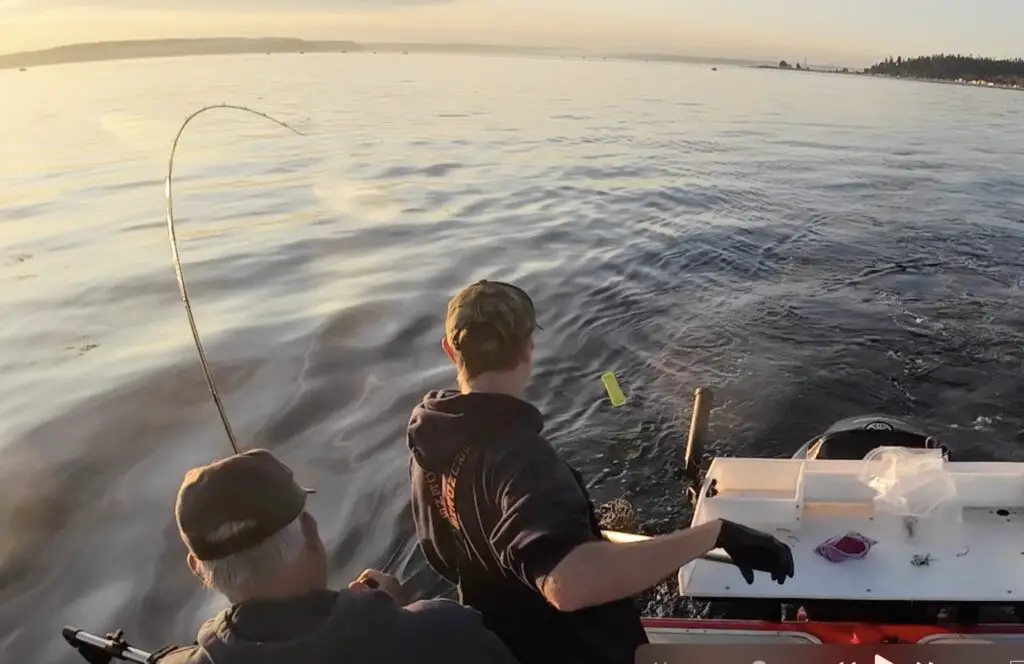
We hooked a nice pink salmon around Skunk Bay as our first fish of the day and almost kept it, but we were optimistic we would get our chinook and coho, so we opted to kick it back. We hooked that pink on our standard Cookies n cream 3.0 spoon behind the Gibbs bonchovy flasher we like to use.
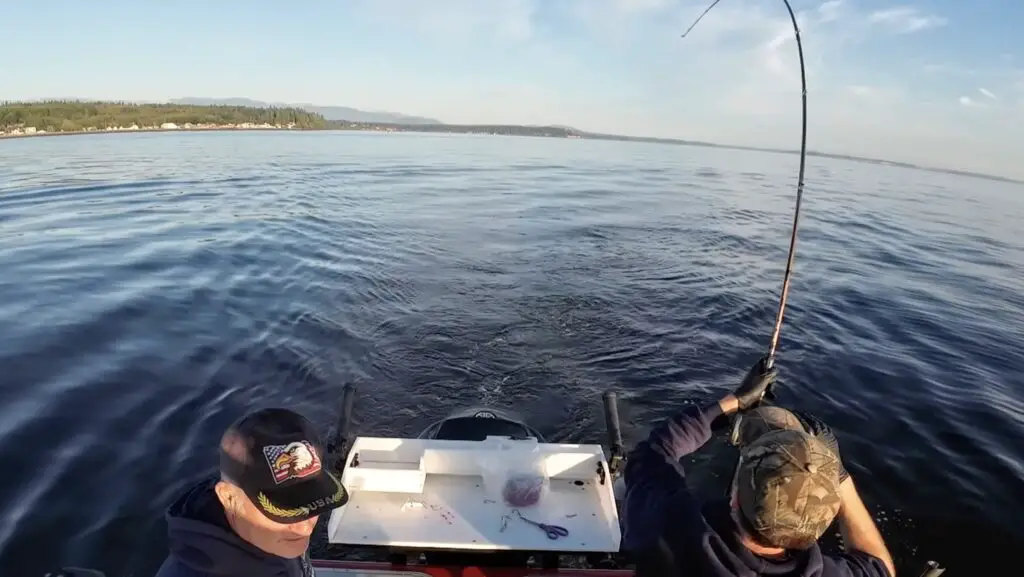
Heading west, we hooked a small, but keeper-sized chinook, that we lost, I suspect it was hooked in a strange spot because it wasn’t huge, but it felt really heavy, making it difficult to bring in and ultimately probably why we lost it.
I hooked that fish on an anchovy in a helmet, and on that setup I have a trailer hook that flops around about 1-2″ behind the anchovy, so sometimes a fish will hook itself outside the mouth when it’s following close behind the anchovy.
On our last run east with the beginning of the flood current, I got another really solid hookup on a chinook that peeled off about 350 ft of line. We were in about 240 ft of water and 120 ft on the wire with the anchovy when it bit.

We got that nice chinook to the net, but it had a nice adipose that meant it was going back into the water. I estimate it was about 15-16 lbs.
We picked up and got past the point, not wanting to deal with the crazy currents right at the point. Now were were trolling south towards Pilot Point in about 90-120 ft of water.
We were hooking into several fish, but they were all aggressive juvenile chinook about 16-20 inches in length.
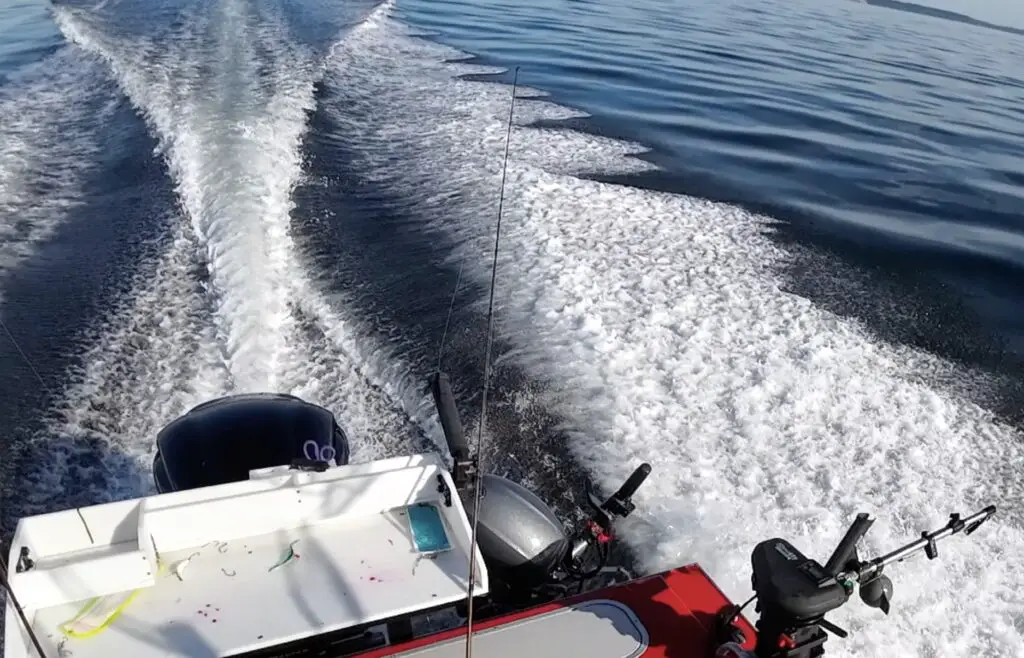
After about the 3rd or 4th fish, I sighed deeply, because I really didn’t want to execute my plan B, which was to join the hordes of boats on the west side of Possession Bar, but we picked up and did exactly that.
It didn’t take us long, after being on the bar to realize why everyone was there. There was a little bit of ebb left, but oh my was there a lot of bait and salmon. Bait was dancing on the surface, you could see hundreds of baitfish just below the surface itself in giant schools being attacked by birds from above and likely coho salmon from below.
Boat traffic easily rivaled any popular salmon fishery in terms of chaos. Boats going all directions in fact.
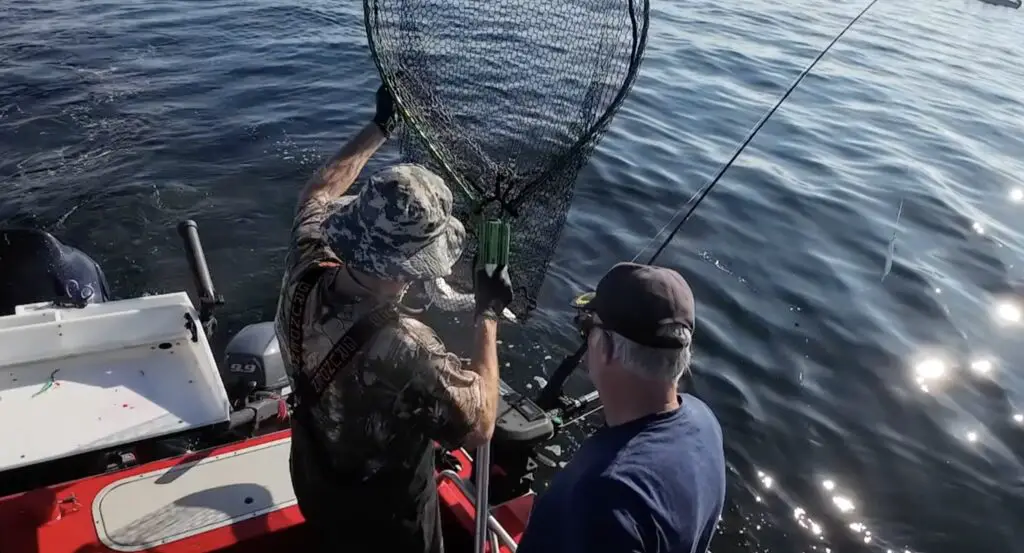
If you ran a rod in the top of the water column, you were going to hook a coho, without question. But we were on a mission for chinook, so we ran deep and managed to hook a few before the bite really died down.
We saw fish on all around us, but most of them appeared to be coho, and the mark rate wasn’t great, so many of them were being kicked back.
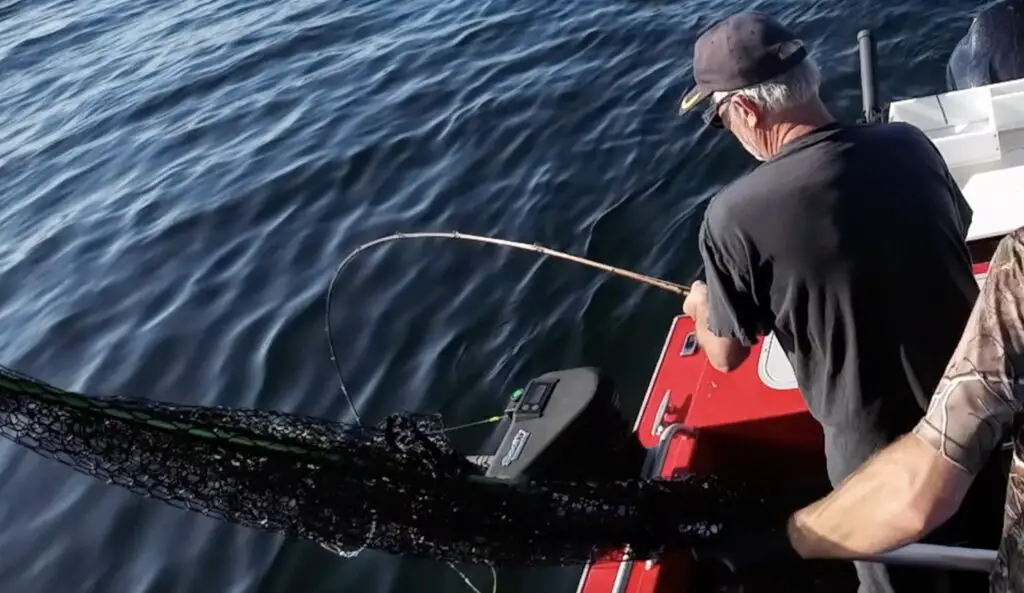
Our first chinook hookup ended up being a clearly mature 8lb hatchery chinook, that again bit on anchovy in the helmet 100 ft down in 120 ish ft of water. We got that fish in the net no problem.
The second nice chinook hookup might be one of my favorite I’ve ever experienced.
I was dropping down to 120 ft on the downrigger, when it came off the clip at around 100-110 ft of cable. I knew exactly what had happened, or at least I thought I did!
I immediately reeled like crazy, but after 5-7 seconds of reeling my line was completely slack and I began to wonder if my line had somehow been cut!
After reviewing the video footage, I reeled like crazy for 12 whole seconds before my rod loaded up with a heavy angry chinook on the end of the line and it was coming to the surface right behind my boat.
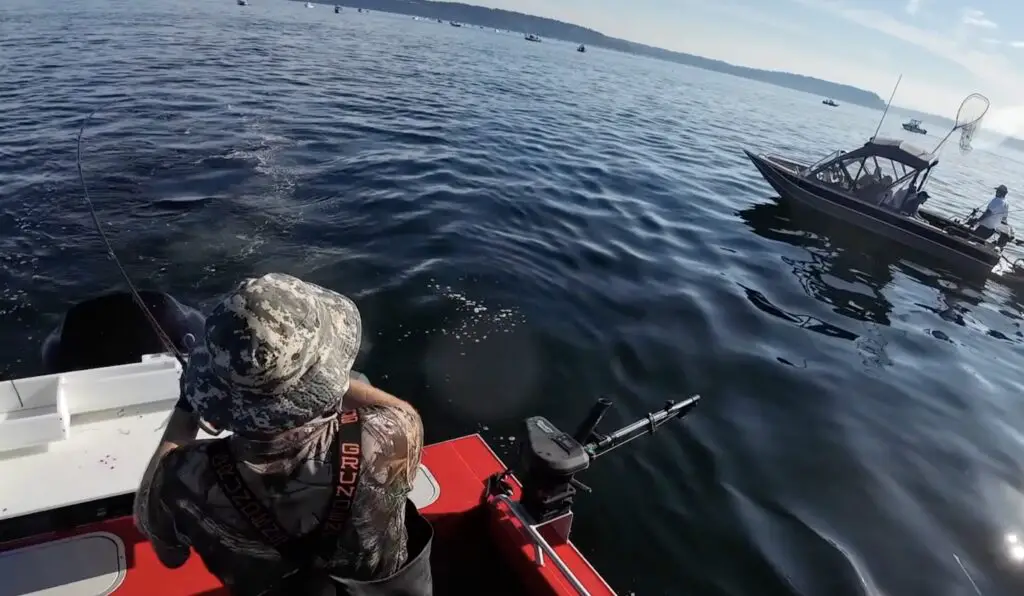
Just as I’ve finally connected with the king salmon and loaded the rod up, another boat is on a collision course for my fish, headed to troll exactly behind my boat, 20 ft behind me. I mean…are you serious?!?
I yell at that boat and they veer off, but now I’m horsing this fish to my left (starboard) to keep it from running into their lines. As the boat passed by, I should have relaxed a bit on the fish to get it to run versus sitting near the surface doing big head shakes, but I was off my game, and within a few seconds of this encounter, the fish was off and swimming back to the deep.
After several more passes, the bite had really dropped off and a flood current had started to pick up, so we went over to the east side of the bar to complete our lower Marine Area 9 tour.
There were far fewer boats, and less activity, though I have no doubt had we stuck it out, we may have encountered some awesome conditions near the end of the flood, but we were running short on time.
We hooked a few more quality unmarked coho before calling quits and heading back to Kingston.
Lessons learned
For starters, I would have started on the west side of the Possession bar. It was a zoo, but we probably would have limited on chinook given a bit more time there during the good part of the bite near the end of the ebb.
Second, that anchovy was absolutely killing it. It was out fishing spoons, hoochies and my new toy the spinfish loaded with a special tuna concoction.
I should have had more! I ran out near the end of our time on the west end of Possession.
Third, I think I’m going to upsize my hooks on that setup. I like to match hook size to bait, and the 3/0 hook is a really good match for the smaller anchovies, but I’m gonna try the 4/0. I just think you lose fewer chinook on a 4/0 or larger hook. I’ve nearly eliminated losing chinook on my spoons, but I’ve got some work to do on this setup to achieve the same outcomes.
With Marine Area 9 now closed to chinook retention, where do we fish now?
Uh…Westport!
Okay, but seriously for the central and north sound fisherman, Westport isn’t practical, so I would say you need to beat the heck out of Marine Area 10, as I’m not sure how long the current sub-legal quota is going to last before it gets shutdown for chinook retention just like Marine Area 11.
We anglers need a better plan going into the 2024 season because the combination of the sub-legal encounter quota with the test-fishing means a single string of bad luck (encountering sub-legal) can quickly shut down a marine area. We are going to leave a lot of Chinook quota on the table this year as a result.
Another option is to go fish for coho and pinks on Possession in Marine Area 9, you will also hook chinook you have to release, but the whole experience will be huge fun without all the boats.
Those boats will be in Marine Area 10 chasing chinook.
One of the mysteries of this season has been the low catch rate in Marine Area 10 compared to the much higher catch rate in Marine Area 9.
My latest theory is that the catch rate dropped off from mid-channel to lower Marine Area 9 spots accounting for some of the difference. Watch for the catch rate to really improve in the first part of August until it closes.